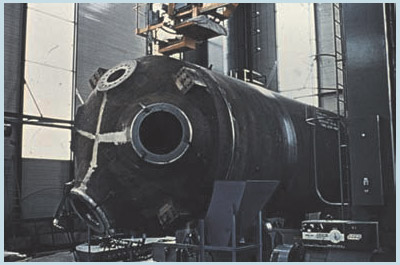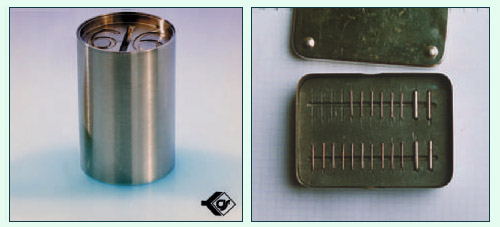Radioactive waste from many different sources…

Future large waste objects
Steam generators are one of main components of pressurized water reactors. EDF has replaced 33 of these units – 15 between 2003 and 2010 – and plans to remove a further 15 between 2011 and 2020. Because they are only mildly contaminated from contact with the slightly radioactive water in the reactor coolant system, these steam generators classified very low-level waste.
© ANDRA (Source: Andra Sheet F3-2-08)
When radioactive waste is mentioned, people mainly think of the waste that comes out of nuclear power plants. But there are other sources of radioactive waste, some of them quite surprising, that are not so much in the spotlight.
Origin should not be confused with the classification based on the activity level and life of the radioactive elements that have to be taken into account when managing waste. So a reactor steam generator, which is only mildly radioactive, is considered to be very low-level waste when it is replaced. This large component falls into the same waste management category as contaminated items recovered when cleaning up the site of an old factory that used to use paint containing radium to make alarm clocks. This very low-level waste (VLLW) is stored at the CIRES waste collection, storage and disposal facility at Morvilliers in Aube.
The French National Radioactive Waste Management Agency (ANDRA) has the job of collecting and deciding how to manage a wide variety of waste.
Items classed as radioactive waste can be relatively small, such as old lightning conductors containing americium and cobalt sources used in hospitals. They can also be relatively large, such as the steam generators periodically replaced by EDF.

Cobalt sources and radium needles
Cobalt bombs, powerful sources of gamma rays, were used in cancer radiotherapies (they were gradually being replaced by small accelerators). After use, these sources, the power of which only decreases by half every five years, have to be recovered. More than 3300 objects for medical uses, such as these radium needles, have also been recovered. Radium was used in brachytherapy in the first half of the 20th Century in the form of needles and tubes. It has been replaced by caesium-137 and iridium-192, which have much shorter half-lives than radium (radium half-life is 1600 years).
© ANDRA
Military waste is a major source. The irradiated fuels from reactors on vessels are similar to the waste from civil reactors, but they are processed separately. There are also residues from nuclear weapons manufacture, which are often covered by defence secrecy. One particular type is tritium-bearing waste, the main source of which is the tritium produced by the French Defence Ministry for its own needs.
Research is in progress to find a method for managing graphite waste from the dismantling of old facilities. However, at present the dismantling is being undertaken of the oldest reactors, which were graphite-moderated gas-cooled reactors. These nuclear power plants, which used natural uranium, deployed a graphite moderator to slow down the neutrons. This graphite moderator would become radioactive from the effect of the neutron irradiation.
The dismantling of graphite-moderated gas-cooled reactors is not indicative of the problems of dismantling pressurized water reactors, which have a much smaller core and which use a liquid moderator – water – from which the radioactivity can be removed much more easily. France’s nuclear reactors are still young and the problems associated with dismantling them have really not yet arisen.
Scrap from uranium mines is dealt with separately. Transporting 50 million tonnes of this scrap to a disposal site would be prohibitively expensive and pointless, because the activity level of this material is almost the same as natural radioactivity. On the other hand, the sites will have to be properly managed so that they do not become polluted by the mining residues.
Other articles on the subject « Waste Inventory »
Recoverable materials
Inventory of reusable uranium and plutonium stocks The radioactive species present in the spent f[...]
France: waste panorama (1)
An overview of French waste categories… In France, radioactive waste is split into five cat[...]
France: waste panorama (2)
An overview of French waste categories (continued)… Low- and intermediate-level short-lived[...]
US panorama
The case of the greatest nuclear power Nuclear-powered US Navy vessels, past production of nuclea[...]
Mining residues
Waste from uranium extraction The residues from processing uranium ores are disposed of on the si[...]
Medicine and research
Radioactive sources, producers of waste outside the nuclear industry… Biology labora[...]
Military waste
A separate system Using the gaseous diffusion process, the AREVA Pierrelatte facility produced en[...]
Radium-bearing waste
Legacy waste – weakly radioactive but long-lived Recent and less recent industrial activities hav[...]
Waste from Dismantling
Dismantling of facilities: graphite waste Experience with dismantling nuclear power plants is onl[...]
Waste from Industry
Obsolete radioactive sources, the legacy of radium applications There are numerous industrial app[...]